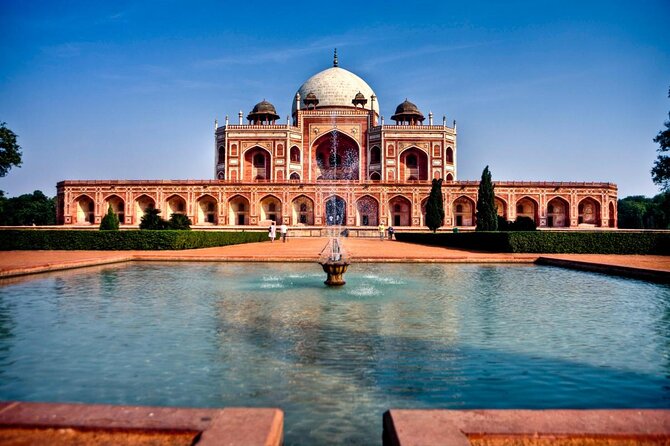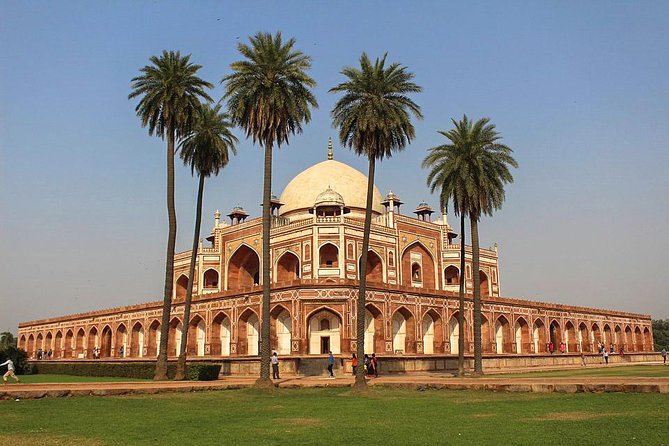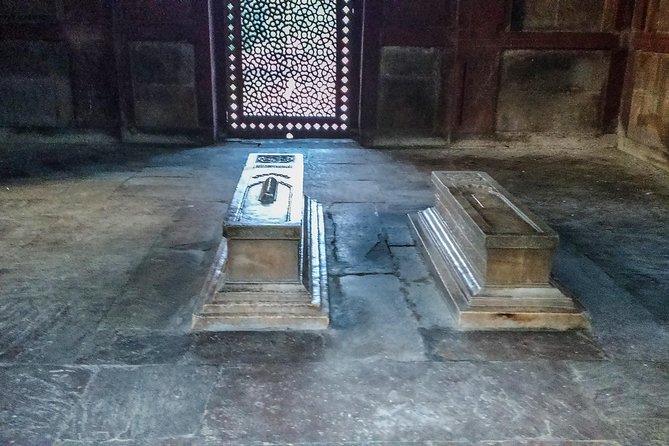Stepping into the serene grounds of the Humayun Tomb Complex, visitors are transported back in time to the grandeur of the Mughal era. This architectural marvel, commissioned in the 16th century, captivates with its harmonious blend of red sandstone and white marble. Beyond the iconic tomb, the complex boasts a rich tapestry of history, from the magnificent mausoleums to the meticulously designed gardens. Unraveling the stories etched in stone and breathtaking vistas, a history walk through this UNESCO World Heritage Site promises to unveil the cultural and artistic legacy that continues to captivate scholars and enthusiasts alike.
Key Points

-
Humayun’s Tomb, a UNESCO World Heritage site, showcases the Mughal architectural prowess with its harmonious blend of Persian and Mughal styles.
-
The tomb’s design incorporates red sandstone and white marble, symbolizing power and purity, with intricate patterns and calligraphy adorning the walls.
-
The complex houses the tombs of other Mughal royalty, reflecting the dynasty’s legacy and contributing to its historical significance.
-
Surrounding gardens and water channels create a serene atmosphere, enhancing the architectural grandeur and integrating nature with the structures.
-
The adjacent Nizamuddin Basti neighborhood offers a glimpse into the daily life and cultural heritage, enriching the overall experience of the Humayun’s Tomb tour.
Architectural Marvels of Humayun’s Tomb
Nestled within the serene landscape of New Delhi, Humayun’s Tomb stands as a testament to the architectural prowess of the Mughal era.
This magnificent mausoleum, commissioned by Humayun’s first wife Empress Bega Begum, is a stunning blend of Persian and Mughal styles. The tomb’s central dome, flanked by graceful arched entrances and ornate minarets, creates a harmonious and visually striking composition.
The intricate and delicate inlaid work on the tomb’s surfaces, including the use of red sandstone and white marble, adds a captivating level of detail.
Humayun’s Tomb isn’t only a significant historical site but also a true architectural masterpiece that continues to captivate visitors from around the world.
If you're enjoying exploring New Delhi on foot, you'll love these other walking tours we recommend
Significance of the Tomb’s Design

The Humayun’s Tomb complex is renowned not only for its grandeur but also for the profound significance embedded in its architectural design.
The tomb’s design draws inspiration from various Persian and Timurid traditions, reflecting the cultural influences of the Mughal era.
Some key features include:
- The use of red sandstone and white marble, symbolizing power and purity
- The central double-domed structure, representing the duality of the physical and spiritual realms
- The intricate patterns and calligraphy adorning the walls, conveying Quranic verses and Persian poetry
- The symmetry and balance of the layout, emphasizing the harmonious coexistence of different elements
- The surrounding gardens and water channels, creating a serene and contemplative atmosphere.
Historical Context of the Complex

Humayun’s Tomb complex holds a rich historical narrative, tracing back to the Mughal era of the 16th century.
The architectural marvel was commissioned by Humayun’s first wife and chief consort, Empress Bega Begum, shortly after the emperor’s death in 1565.
Sitting on a raised platform, the tomb is surrounded by a complex of mosques, gates, and gardens that collectively showcase the Mughal architectural style.
The complex also includes the tombs of other Mughal royalty, making it an important historical site that reflects the power and legacy of the Mughal dynasty.
Visitors can explore the intricate designs, inscriptions, and the overall grandeur that have earned the complex a place on the UNESCO World Heritage list.
Remarkable Mausoleums Within the Complex
Aside from Humayun’s grand mausoleum, the complex houses several other remarkable tombs that provide a glimpse into the architectural grandeur and legacy of the Mughal empire.
These include:
- The tomb of Isa Khan Niyazi, a prominent 16th-century Afghan noble who served under Humayun and Akbar.
- The tomb of Afsarwala, a lesser-known Mughal prince.
- The Bu Halima Garden Tomb, a tranquil resting place surrounded by lush greenery.
- The Arab Sarai Gate, a magnificent entrance to the complex showcasing intricate red sandstone carvings.
- The tomb of Barber Shuja, a court official during Humayun’s reign, featuring a unique octagonal structure.
These tombs, scattered throughout the complex, offer visitors a captivating journey through Mughal architectural and cultural heritage.
Landscaping and Gardens of the Complex
Within the expansive Humayun’s Tomb complex, visitors will discover meticulously landscaped gardens that complement the architectural grandeur.
The gardens feature lush greenery, ornamental plants, and symmetrical pathways, reflecting the Mughal tradition of blending nature with structures.
Ornate water channels and fountains add a serene ambiance, while the tomb’s reflection in the central pool creates a picturesque scene.
Visitors can stroll through the tranquil gardens, admiring the harmonious blend of design and nature.
The landscaping not only enhances the visual experience but also provides a peaceful respite from the bustling city.
Exploring the well-maintained gardens is an integral part of understanding the Mughal architectural and design aesthetic at Humayun’s Tomb.
Fascinated by New Delhi's past? More historical tours we've covered
- Private Full-day Historical Adventure Tour in Agra by Gatimaan Express
- Discover Delhis Cultural Heritage in a Day With Food Tasting
- Gandhi Delhi Private History Adventure Tour
- 3-4 Hour Old Delhi Heritage Walk Tour With Tuk Tuk Ride Wherever Required
- Delhi a Historic and Heritage 7 Hours Experience Trip
- 3-Hour Old Delhi Heritage Walking Tour With Rickshaw Ride
Insights Into Humayun’s Life and Legacy
Stepping beyond the serene gardens, the Humayun’s Tomb tour offers a captivating glimpse into the life and legacy of the Mughal Emperor Humayun.
Visitors learn how Humayun’s defeat and subsequent exile shaped his character and vision, leading to his ultimate restoration as the second Mughal ruler.
The tour highlights:
- Humayun’s scholarly pursuits, including his love of astronomy and Persian literature
- His military campaigns and the challenges he faced in securing the Mughal throne
- The architectural influences that inspired the tomb’s design, reflecting Humayun’s multicultural upbringing
- His patronage of the arts, fostering a golden age of Mughal culture
- The lasting impact of Humayun’s reign on the Indian subcontinent’s history and heritage.
Exploring the Nizamuddin Basti Neighborhood
The Humayun’s Tomb tour also explores the vibrant Nizamuddin Basti neighborhood, a historic urban community adjacent to the iconic mausoleum.
This densely populated area is home to shrines, mosques, and the dargah (shrine) of the revered Sufi saint, Nizamuddin Auliya.
Visitors can wander through the bustling lanes, observing the daily life of the residents and learning about the area’s rich cultural and architectural heritage.
The tour provides insight into the symbiotic relationship between the tomb complex and the surrounding neighborhood, highlighting the integral role of the Basti in the broader Humayun’s Tomb experience.
Practical Considerations for the Tour
To make the most of the Humayun’s Tomb tour, visitors should consider a few practical factors.
The tour starts at 8:00 AM, allowing guests to explore the complex during the cooler morning hours. Free cancellation is available up to 24 hours before the experience, and a "reserve now, pay later" option is provided for convenience.
While the tour isn’t wheelchair accessible, it’s suitable for most travelers with a moderate fitness level. Visitors should also note that camera usage fees at historic sites are included, but recommended gratuities are not.
- Early morning start time
- Flexible cancellation policy
- Reserve now, pay later option
- Moderate physical fitness required
- Camera usage fees included
Frequently Asked Questions
Can I Add Extra Stops to the Tour Itinerary?
Yes, visitors can add extra stops to the Humayun’s Tomb tour itinerary. The private guided tour offers flexibility, allowing travelers to customize the experience based on their interests and available time.
Is It Possible to Visit the Tomb in the Afternoon?
Visiting Humayun’s Tomb in the afternoon is possible, but the early morning tour is recommended. The afternoon heat can be intense, and the crowds tend to be larger. Booking the morning tour provides a more comfortable and personalized experience.
Are There Any Special Discounts or Packages Available?
There are no special discounts or packages available for the Humayun’s Tomb tour. However, the tour operator offers a flexible cancellation policy and a reserve now, pay later option for added convenience.
Can I Bring My Own Food and Drinks Into the Complex?
Visitors can bring their own food and drinks into the Humayun’s Tomb complex. However, they’re advised to avoid consuming them inside the main tomb structure to maintain the site’s sanctity and cleanliness.
How Long Does the Guided Tour Typically Last?
The guided tour of Humayun’s Tomb typically lasts around 1.5 to 2 hours, allowing visitors to explore the complex’s architecture, history, and significance under the knowledgeable guidance of a local expert.
Recap
The Humayun Tomb Complex offers a captivating historical journey, showcasing the architectural brilliance and cultural heritage of the Mughal era. Visitors can explore the intricate gardens, majestic mausoleums, and serene landscape, gaining insights into Humayun’s life and legacy. This experience provides a unique opportunity to take in the rich tapestry of India’s past, leaving a lasting impression on all who explore this remarkable historical site.
More Historical Tours in New Delhi
- All Inclusive: Private Heritage & Historical Delhi Sightseeing Tour
- Delhi’s Formidable History Show Review
- Spiritual and Heritage Discovery Tour Review
- Old Delhi Heritage Walking Tour With Rickshaw Ride
- Ajanta Ellora Caves From Delhi (With Flights) – a Private Luxury Heritage Tour
- Private Indian Cultural & Heritage Tour
More Walking Tours in New Delhi
More Tour Reviews in New Delhi
Not for you? Here's more things to do in New Delhi we have recnetly reviewed
- 4 Best Guided Tours In Faridabad
- 20 Best 2 Day Tours In New Delhi
- 20 Best 3 Day Tours In New Delhi
- 20 Best 4 Day Tours In New Delhi
- 10 Best Cruises And Boat Tours In New Delhi
- 13 Best Dining Experiences In New Delhi
- 20 Best Full-Day Tours In New Delhi
- 20 Best Photography Experiences In New Delhi
- 12 Best Dinner Tours In New Delhi
- 25 Best Food Tours In New Delhi
- 25 Best Lunch Experiences In New Delhi
- From Delhi:-Privet Tajmahal Agra Fort & Baby Taj Day Trip
